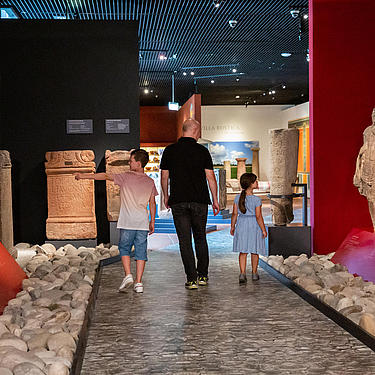A Touch of Rome
With the expansion of the Roman Empire, the Roman Mediterranean way of life arrived at the Rhine and Neckar region. Hence, the archaeological artefacts exhibited in the section “A Touch of Rome” illustrate a multicultural society from the 1st to the 4th century.
The region of Mannheim was once home to Celts, Germanic tribes, Neckarsueben and members of the Roman troops, who literally came from all around the world. The exhibition tour takes you along a Roman road with numerous stone monuments steeped in history. You can even put your knowledge of Latin and Roman gods to the test on these the gravestones and altars. Elector Carl Theodor had the stones brought to Mannheim in the 18th century from places including Mainz, the Rhineland, and the Danube. When the castle was destroyed in the Second World War, the precious artefacts were severely damaged. Thanks to a generous funding of the Mannheim Antiquities Society, costly cleaning and restoration measures could finally be carried out and the Roman stone monuments can be admired again in the exhibition.
The detailed reconstruction of Roman wall paintings from a villa near Oftersheim is another highlight of the presentation. The fragments of the frescoes were already recovered during excavations 50 years ago, but it is only recently that they could be assembled and reconstructed with patience and detective flair. The murals are of the highest quality and testify the wealthy lifestyle of Romans living far from the capital. The exhibition further shows that also rivers can be veritable treasure troves for traces of the past. In the middle of the 3rd century, Germanic tribes took advantage of weak Roman border defences for raids in the west. On their way back to their own territory, they had to cross the Rhine and Neckar and were confronted by Roman troops in certain places. The fully loaded ships capsized and the booty sank into the water, where they were discovered centuries later by archaeologists.
The exhibition tour ends with the section “Fierce People in the Rhine and Neckar Area”.
